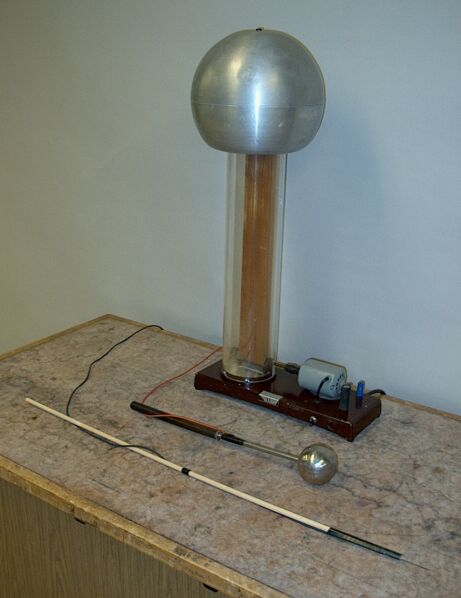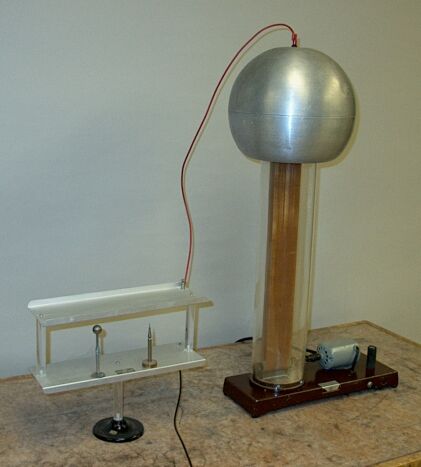 |
 |
IMPORTANT DISCLAIMER: The way this demonstration works is NOT the way lightning rods protect buildings in thunderstorms! (Though it is related. Vide infra.)
With the setup pictured at left, hold the spherical end of the short wand near the sphere of the Van de Graaff generator to draw sparks. While still drawing sparks, with your other hand hold the needle end of the long wand near the sphere of the Van de Graaff. The sparks cease. Remove the large wand, and the sparks recommence. With the setup pictured at right, there will be no sparks when the Van de Graaff is turned on. With the Van de Graaff still going, push the pointed rod from between the parallel plates. Sparks immediately occur between the top plate and the sphere at the top of the small rod. You can remove the pointed rod by hand, then put it back to stop the sparks, but if you do this, make sure that until the entire rod is outside the electric field, the base is in contact with the lower plate. If you lift it even slightly above the lower plate, it will be at a significant potential above ground, and you will get a shock! Alternatively, you can use the ball wand or some other insulated prod to push the pointed rod out of the way. (Hmm. . . I suppose I could attach a ground line to its base. . .) Important! Always use the grounded wand to turn the generator on and off.
What is going on?
The Van de Graaff generator charges its metal sphere to a high potential (proportional to the amount of charge on it). If the potential of the sphere is high enough, when you bring the grounded ball wand within a few inches of it, the air between the sphere and the wand “breaks down,” and the sphere discharges castastrophically in an arc. In air, there are always a few electrons and ions, either from cosmic ray bombardment or natural radioactivity. Breakdown occurs when the electric field is large enough that within their mean free path, these electrons can gain enough energy to ionize the gas molecules with which they collide. The positive ions thus formed are then accelerated in the opposite direction to the electrons and collisionally excite, and undergo charge exchange with, other air molecules. Some strike the dome of the van de Graaff generator (if it is negative; if it is positive, they strike the wand) with enough energy to eject electrons, which ionize more gas molecules. Some of the ions recombine with electrons, and others ionize other gas molecules via charge exchange. The result is the formation of a conductive path from the sphere of the Van de Graaff generator to the ground wand, through which the sphere of the Van de Graaff generator quickly discharges. The light we see is emission from electronically excited molecules (either collisionally excited or formed by ions that have recaptured electrons) relaxing to lower energy levels, and the crack is the shock wave formed by the rapid expansion of the air that has been suddenly heated by the arc.
Why does bringing the pointed wand near the sphere of the Van de Graaff generator, or having the pointed rod inside the lightning rod apparatus, suppress the arcing? The electric field around an object depends on the charge density on its surface. For a given electric potential, the smaller the object, the greater the surface charge density, and the greater the electric field. At a sharp point, the electric field can be huge. In such a large field, not only do any electrons present acquire enough energy to ionize surrounding air molecules, but ionized air molecules, even in their short mean free paths, can acquire enough energy to ionize other air molecules. In addition, if the point is negatively charged, it is possible for electrons to be emitted from its surface. Whichever way it is charged, the field can be high enough to cause ionization of the surrounding air (by polarizing molecules so strongly that they release electrons). Because of the large number of electrons and ions thus formed, the air near the sharp point becomes much more conductive than normal. This provides a path for charge to flow from the object that is producing the field, into the point (or vice versa). In this way, the pointed wand can draw charge away from the sphere of the Van de Graaff generator fast enough to prevent the potential difference between it and the grounded spherical wand from becoming high enough to cause breakdown. This silent type of discharge near sharp points is called corona discharge.
Without the pointed rod near the Van de Graaff generator, then, you get arcing between the generator and ball wand, and when you bring the pointed wand near the generator, the arcing stops. Similarly, in the lightning rod apparatus, as long as the pointed rod is between the plates, there is no arcing, but when it is removed, arcing occurs between the ball and the top plate.
Is this how real lightning rods work? No, it is not. Actually, while sufficient to suppress arcing from a small Van de Graaff generator, the current produced by corona discharge around a point is far too small to dissipate the huge numbers of charges that build up in thunderclouds. Instead, lightning rods provide points where, when a thundercloud approaches, discharges can occur in the form of traveling sparks. Such a discharge provides a conductive path to the lightning rod, and in extending upward to meet the lightning stroke, diverts it to the rod, through which the current is drawn safely to the ground. The lightning rod and the wires connecting it to the ground must, of course, be sufficiently heavy to carry the tremendous currents (tens of kiloamperes on average) delivered by a lightning bolt, and the system must be properly grounded.
The history of the lightning rod and of the ideas regarding its means of operation begins with Benjamin Franklin. In his experiments in electrostatics with blunt and pointed rods, Franklin noticed that discharges between smooth or blunt conductors occur via loud arcs, but conductors with sharp points discharge silently. This led him to wonder whether pointed rods, placed appropriately on buildings and grounded, might “. . .draw the Electrical Fire silently out of a Cloud before it came nigh enough to strike. . .” and thus avert a direct lightning strike. Once people began to install lightning rod systems on buildings, it soon became obvious that this was not the manner in which lightning rods worked, but, rather, the one described above was. Indeed, in his advertisement in the 1753 issue of Poor Richard's Almanac, after a description of the method of installing a lightning rod system, Franklin writes, “. . .A House thus furnished will not be damaged by Lightning, it being attracted by the Points, and passing thro the Metal into the Ground without hurting any Thing. . .” You can find the above quotes in an article that appeared in the January, 2006 issue of Physics Today, Benjamin Franklin and Lightning Rods, by E. Philip Krider. In the June, 1967 issue of Journal of the Franklin Institute, R.H. Golde gives, in The Lightning Conductor, a thorough presentation of the theory of lightning rods, experiments with long spark discharges, and an analysis of what happens in a lightning strike. In this paper, taking an estimate of 50 µA for the current from corona discharge in a pointed rod in an average electric field of 200 V/cm under a thundercloud, average dissipated charge of a lightning flash of about 30 coulombs and an average flash rate of two per minute, Golde calculates that it would take 6,000 such rods placed over an area of perhaps half a square mile to prevent one lightning flash. This paper also contains a photograph of a lightning bolt striking the lightning conductor on a tall chimney, in which the sharp bend the lightning takes from its original path to strike the lightning rod is clearly visible.
In writing these notes, I also used the following:
1) Uman, Martin A. All About Lightning (New York: Dover Publications, Inc., 1986). This book poses a series of commonly-asked questions about lightning, each followed by the answer. Chapter 2 explains how a lightning rod works, and it has diagrams that show the optimum arrangements for lightning rods on buildings, and the techniques used to protect high-tension lines from lightning strikes.
2) Uman, Martin A. Lightning (New York: Dover Publications, Inc., 1984). This book gives a thorough background in the study of lightning – how it forms, photography, measurements of various types, and theory of the discharge process. Both Lightning and All About Lightning give many interesting references.
3) Halliday, David and Resnick, Robert. Physics, Part Two, Third Edition (New York: John Wiley and Sons, Inc., 1978). Page 640 has a note regarding corona discharge.
4) G.W. Trichel gives a good description of the mechanism of negative corona discharge across a gap in Physical Review, 54, 1078 (1926). (Since the dome of the Van de Graaff generator charges negative, the grounded point is positive, and the corona discharge is of the opposite sign.)
5) Two papers that discuss field emission from points are Millikan, R. A. and Eyring, Carl F. Physical Review, 27, 51 (1926) and Eyring, C. F., Mackeown, S. S. and Millikan, R. A. Physical Review, 31, 900 (1928).
6) Hyperphysics entry on the Van de Graaff generator and ionization of air.